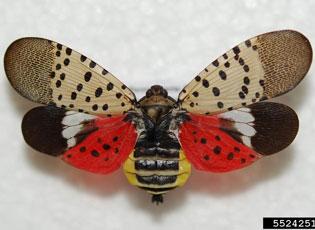Lycorma delicatula (White) (Barringer et al. 2015)
Spotted lanternfly (SLF)
China (Dara et al. 2015)
First detected in 2014, but appeared to have been present in the U.S. for 2-3 years (Dara et al. 2015; Barringer et al. 2015)
Possible pathways include imported woody plants, wood products, and other commodities (EPPO 2016)
Poses a serious economic threat to multiple U.S. industries, including viticulture, fruit trees, ornamentals and timber (Urban et al.)

Spotted lanternfly, adult
Photo by Lawrence Barringer, Pennsylvania Department of Agriculture
Spotlights
Distribution / Maps / Survey Status
Quarantine
All Resources
Selected Resources
The section below contains highly relevant resources for this species, organized by source.
Partnership
Federal Government
International Government
State and Local Government
Academic
Barringer, L.E., L.R. Donovall, S. Spichiger, D. Lynch, and D. Henry. 2015. The first New World record of Lycorma delicatula (Insecta: Hemiptera: Fulgoridae). Entomological News 125(1):20-23.
